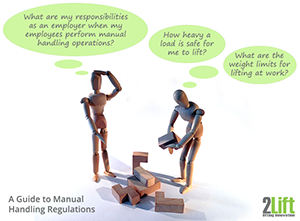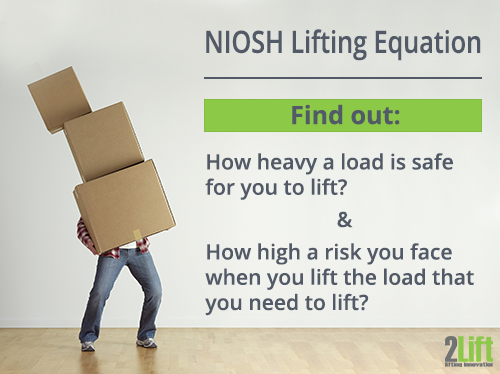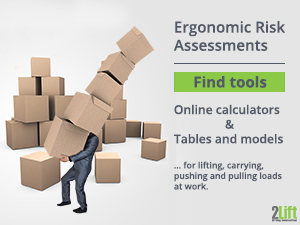Manual Handling Operations, Regulations and Ergonomic Risk Assessment Tools for Norway
Even though Norway is not an EU member state, Norway's legislation on occupational safety and health is "in accordance" with the EU Framework Directive 89/391, which is set in place to protect the health and safety of workers. (reference).
Basically this means that Norway's national regulations regarding manual handling operations is very similar to those of EU member states and is built on many of the same models (just like what is the case with the non-EU country of Switzerland).
Anyway, this page intends to give you quick and to-the-point insights into manual handling authorities, safety laws, ergonomic guidelines and good lifting practices in Norway.
So what you'll get on this page is:
- An introduction to the authority managing and the laws pertaining to manual handling in Norway.
- Ergonomic guidelines and good practices for manual handling operations in Norway.
- Weight lifting limits to lifting, pushing and pulling at work.
- Links out to both simple and more extensive ergonomic risk assessment tools for the manual handling of loads.
The Authority Responsible for and the Legislations Concerning Manual Handling in Norway
In Norway we have the government agency the Norwegian Labour Inspection Authority / Arbeidstilsynet who is responsible for ensuring that companies and organizations follow the national occupational safety and health legislation, which in Norway is called the Norwegian Working Environment Act / Arbeidsmiljøloven. (The Norwegian Labour Inspection Authority also constitutes the national Norwegian EU-OSHA focal point).
The Norwegian Working Environment Act outlines employers' responsibilities and duties towards their employees and is set in place to ensure a good and meaningful working environment along with protecting the safety and health of workers.
Avoiding or at least reducing the risk of occupational hazards such as accidents and injuries sustained from manual handling operations is an important part employers' responsibilities.
If you're curious to find out more about Norwegian employers' responsibilities regarding the manual handling of loads as it is stated in the Norwegian Working Environment Act, you can read about them here: § 23-1. Risikovurdering ved planlegging, utforming og utførelse av manuelt arbeid.
Basically this paragraph states that in the evaluation of health risks from manual work, the employer must pay special attention to:
- The nature of the load (weight, geometry, 'handle-ability' etc.)
- The physical efforts required (twisting the trunk, motioning the load etc.)
- The characteristics of the working environment (spacial restraints, flooring, working heights, temperature, lighting etc.)
- The characteristics of the handling task (frequency, transporting distance, variation, pace etc.).
It is also the responsibility of the employer to perform ergonomic risk assessments of potentially risky manual handling operations. And if a manual handling task 'falls short', meaning it is seen as endangering the worker's health, the employer must take corrective actions to eliminate or reduce the risk. This can be done by e.g. introducing mechanical manual handling aids and equipment.
If your company is considered to be in a potentially 'risky' line of business in relation to your workers' occupational safety and health, the Norwegian Labour Inspection Authority may tell you that you need to coorporate with an approved bedriftshelsetjeneste (BHT), which is a a 'corporate health service' who will then monitor your working environment to make sure it lives up to the required standards as stated in the Working Environment Act.
Fortunately the Norwegian Labour Inspection Authority has a certain amount of employer-orientated, easy-to-read material on ergonomics and manual handling available online where they provide simple guidelines to follow and tools to use for a quick risk evaluation (we will go through this next).
There are also more extensive risk evaluation tools available, which are not Norwegian in origin, but are written in Norwegian. These are also published by the Norwegian Labour Inspection Authority (we will link out to these in the risk assessment section further down).
Most material, however, seeming only exist in Norwegian.
Ergonomic Guidelines for the Manual Handling Operations in the Norway
As you may already be fully aware of, the manual handling of heavy objects such as lifting, carrying, holding, pushing and pulling loads, may put the muscle, joint and skeletal system under stress and thus may over the long haul lead to injuries such as MSDs (musculoskeletal disorders).
In order to avoid such health risks, employers are required to follow certain ergonomic guidelines for manual handling operations.
The first and most important guideline is very simple and is about eliminating the risk altogether:
- thus to avoid the manual handling of heavy objects completely!
If that is not possible (which may often be the case), then:
- the work must be re-organized so that the worker is exposed to as small a health risk as possible.
The primary way to organize the manual handling task in such a safe and healthful way is to use technical equipment such as appropriate lifting and handling devices.
Weight Limits for Manual Lifting at Work in Norway
In Norway (as is the case in many other countries) there are certain weight limits as to how much you are recommended to lift at work (manually, without the use of anything else than your own body).
 The maximum weight limit for lifting under optimal conditions is:
The maximum weight limit for lifting under optimal conditions is:
- 25 kg for men
- 15 kg for women
Objects weighing 3 kg or less is considered safe under most circumstances.
Optimal conditions according to the lifting model mean, among other things, that you are lifting the load:
- While standing up (vs. sitting down)
- At around hip's height
- At about a forearm's distance from the centre of the body (app. 30 cm).
If the conditions are less than optimal, the weight of the load must be reduced.
Less than optimal conditions may mean that:
- The load is too large, unmanageable or with poor hand-grasping options
- Too strenuous physical efforts are required to perform the task, such as a twisting of the trunk, handling the load at too high or too low a position, or too far away from the centre of the body
- The handling takes place in a challenging working environment characterized by e.g. restrictive working spaces, uneven or slippery floors, too high or too low temperatures etc.
- A manual handling task is repeated too frequently, at too high a pace, with too little variation, with too little rest etc.
It is specifically recommended that you avoid or pay special attention when:
- Using staircases
- Handling heavy objects when sitting down
- Carrying loads more than 20 meters
- Llifting more than 6000 kg per day (for standing and walking tasks)
- Lifting more than 3000 kg per day (for sitting tasks)
- Working with elements above shoulder height
Weight Limits for Pushing and Pulling Loads at Work in Norway
 If pushing and pulling a load is required, there are also limits as to how much many kg it is recommended that transport.
If pushing and pulling a load is required, there are also limits as to how much many kg it is recommended that transport.
A very simple model shows you that if you push and pull:
- More than 500 kg, it is "often problematic"
- Between 200-500 it "may be problematic"
- Less than 200 kg it is "rarely problematic"
Ergonomic Risk Assessment Tools for Manual Handling Operations for Employers
As already mentioned, it is the responsibility of the employer to ensure a safe and healthy working environment for their workers. One way to do this is to perform ergonomic risk assessments of manual handling operations to make sure that the tasks do not constitute health risks.
General Risk Assessments of Work Tasks
The Norwegian Labour Inspection Authority has created several risk assessment sheets with the aim of identifying safety and health risks at the workplace. They, among other things, state that three simple questions may be enough to start a risk evaluation process of working tasks.
All you need to ask is:
- What can go wrong?
- How can we avoid this?
- What can we do to reduce the consequences if it does go wrong?
You can find three simple risk assessment sheets below (they are general in nature and not specifically aimed at manual handling operations as such):
Risk Assessments of Manual Handling Operations Specifically
Quick and Simple Ergonomic Risk Assessments of Manual Handling
As an employer you may not have extensive insight into ergonomics, plus you may be busy and don't find that you have the time to eat your way through heavy documents to extract practically applicable information.
Luckily the Norwegian Labour Inspection Authority has created some very simple tools for employers. Easy and user-friendly models of how much it is recommended that you lift, push and pull may be found here. (please note that if you scroll down the page quickly you won't see the models, they only appear in drop-down menus).
These models use a simple color code (red is high health risk, yellow is potentially risky, and green is fairly safe) to communicate how risky a certain manual handling task is.
If the manual handling task falls into a risky zone, it is recommended that you carry out further risk assessments.
More Comprehensive Risk Assessments
If you want to be thorough and have a little more time to dedicate to risk analysis, there are more extensive tools for you which entails filling out an ergonomic risk assessment sheet.
These ergonomic risk assessment tools are what safety and health professionals may use. Their origin is not Norwegian (German and British, respectively), but the Norwegian Labour Inspection Authority has published Norwegian versions intended for Norwegian risk evaluation professionals e.g. for those within Bedriftshelsetjenesten (BHT).
KIM - Key Indicator Method
- for risk evaluating lifting, carrying and holding activities
Even though the main target group is professionals, this risk assessment sheet is fairly simple to fill out.
The steps are as follows. You need to choose:
- The kind of lifting activity (lifting, holding or carrying) you want to evaluate along with its frequency (for lifting), duration (for holding) or distance (for carrying).
- The load effect in kg for either men or women
- Working postures
- Working environment conditions
When filling out the sheet, each element is attributed a value, all of which together constitute a risk score. If the risk score is lands somewhere in the yellow or red area, further analysis and corrective actions are advised.
KIM - Key Indicator Method
- for risk evaluating pushing and pulling activities
This tool works in basically the same ways as the one above except that the steps to follow are different and related to pushing and pulling.
When filling out the assessment sheet, you need to choose:
- The length of the transport activity (short or long) along with its frequency (for short distance) or total distance (for long distance).
- The load weigh and type of transport aid for rolling loads or load weight for sliding loads
- The accuracy of positioning along with the speed of movement
- The working position
The working environment conditions
The KIM methods is developed by Federal Institute for Occupational Safety and Health (BAuA) and Länder Committee for Occupational Safety and Health (LASI).
MAC - Manual Handling Assessment Charts
- for lifting and carrying - either alone or in situations involving several persons
In our view, the MAC tool is a little more technical and comprehensive to use than the KIM method, but other than that, it works in a very similar way. The lifting task is pinned out in steps with different scores according to the perceived risk, and at the end all values are added together and provide an overall risk score which may or may not require further action.
The steps to evaluate are e.g.:
- Weight and frequency
- Hand/load distance from the centre of the body
- Vertical lifting distance
- Potential trunk twists
- Hand grasping options on the load
- Flooring and other environmental factors
The MAC tool is developed by Health and Safety Executive (HSE) and Health and Safety Laboratory (HSL) in the UK.
Other Online Links from The Norwegian Labour Inspection Authority Related to Manual Handling

Information Disclaimer
We have done our very best to ensure the accuracy and reliability of the information presented on this page. However, we cannot guarantee the correctness of any information (regulations change from time to time, responsibilities change hands, etc.). Thus we cannot accept any responsibility or liability for the accuracy, content, completeness, legality, or reliability of the information provided here.
If, however, you are aware of any outdated or incorrect information on this page, you are very welcome to contact us, so we can bring our page up to date.
Other Pages on Manual Handling Regulations

Manual Handling Regulations Guide |

The NIOSH Lifting Equation |

Ergonomic Risk Assessment Tools |
Country Specific Pages with Ergonomic Guidelines and Risk Assessment Tools

UK |

Germany |

Austria |

France |

Ireland |

The Netherlands |

Denmark |

Sweden |

Spain |

Portugal |

Italy |

Switzerland |

Norway |

Canada |

Australia |
|
|
|